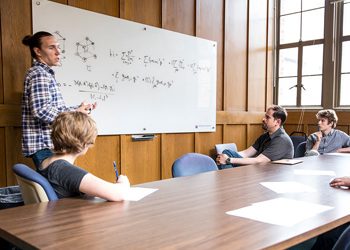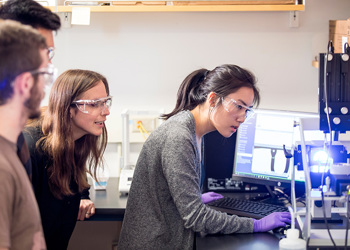Academic Experience

The University of Washington Master of Science in Applied Chemical Science & Technology program is designed to prepare graduates for a range of applied chemistry jobs in industry and research.
Program Format
The program is a full-time, one- or two-year degree, depending on the track you pursue.
Classes meet during the day on the main UW campus in Seattle. There are no classes during summer quarter.
A Flexible Curriculum
The Master of Science in Applied Chemical Science & Technology is a flexible program that allows you to tailor your learning experience to align with your scientific interests and career goals.
There are three tracks to choose from: the one-year Course-Based Track, the one-year Research Track, or the two-year Research & Thesis Track, where you’ll deepen your research and conclude with a thesis.
No matter the track, the program offers a wide range of core and elective classes and laboratory experiences. Delve into topics such as analytical electrochemistry, instrumental analysis, chemical separation techniques, computational chemistry, quantum chemistry, big data for materials science, biomolecular analysis. For more information, see a list of core and elective classes or review sample course plans.
Program Tracks
You can pursue one of three tracks in the Master of Science in Applied Chemical Science & Technology. To start, you choose either the one-year Course-Based or Research Tracks. At the end of the first year, after demonstrating satisfactory progress, those in the Research Track can petition to continue to the two-year Research & Thesis Track.
| Course-Based Track | Research Track | Research & Thesis Track | |
|---|---|---|---|
| Total Credits Earned | 36 | 36 | 48 |
| Duration | 1 year | 1 year | 2 years |
| # of Core & Elective Courses | 11 | 8 | 8 |
| Research | None | 3 quarters of research with a UW research group | 6+ quarters of research with a UW research group, concluding with a thesis |
For specific degree requirements for each track, see Courses & Requirements.
Course-Based Track
In this track, you’ll learn about the cutting-edge instrumentation and informatics being used to solve real-world problems in applied chemistry today. You’ll round out your studies with three research or laboratory courses of your choosing.
Research Track

In this track, in addition to your coursework, you’ll build research skills in cutting-edge chemistry instrumentation and informatics through hands-on experience with a UW research group.
Because career interests vary, and the chemical science field encompasses so many topics and applications, you can choose to work with faculty in the Department of Chemistry in nearly a dozen research areas or with faculty in other departments doing chemistry or interdisciplinary research.
In the past, students have conducted research with the UW Departments of Biochemistry, Atmospheric & Climate Science, Chemical Engineering, Laboratory Medicine & Pathology, Materials Science & Engineering, Mechanical Engineering, Medicinal Chemistry, the Institute of Protein Design and the School of Oceanography.
Research & Thesis Track
This track is an optional continuation of the Research Track. In this track, you’ll develop an individual project related to the goals of your research group in your second year. You’ll learn about scientific writing, publishing and presentation as you develop and defend a thesis under the supervision of your faculty mentor.